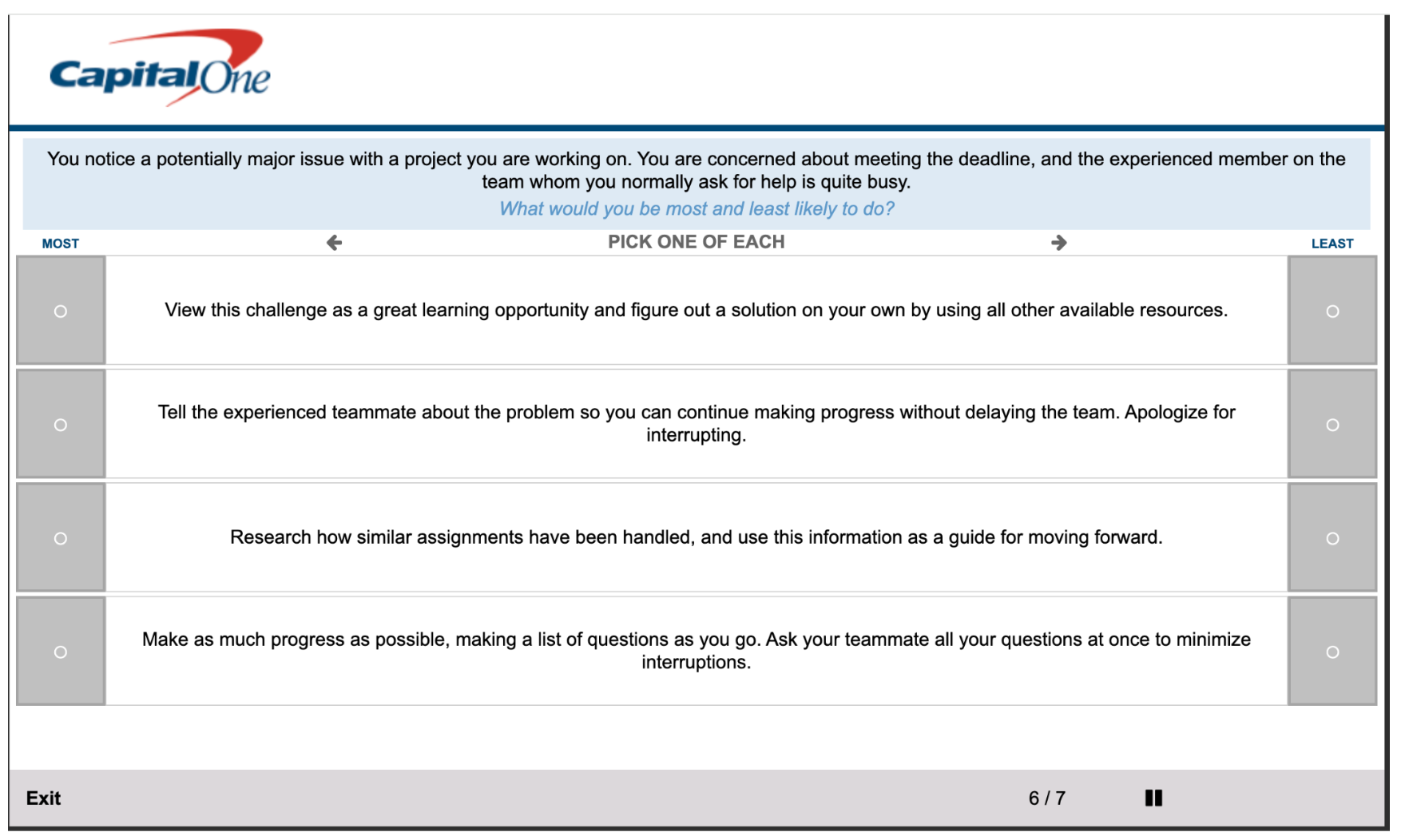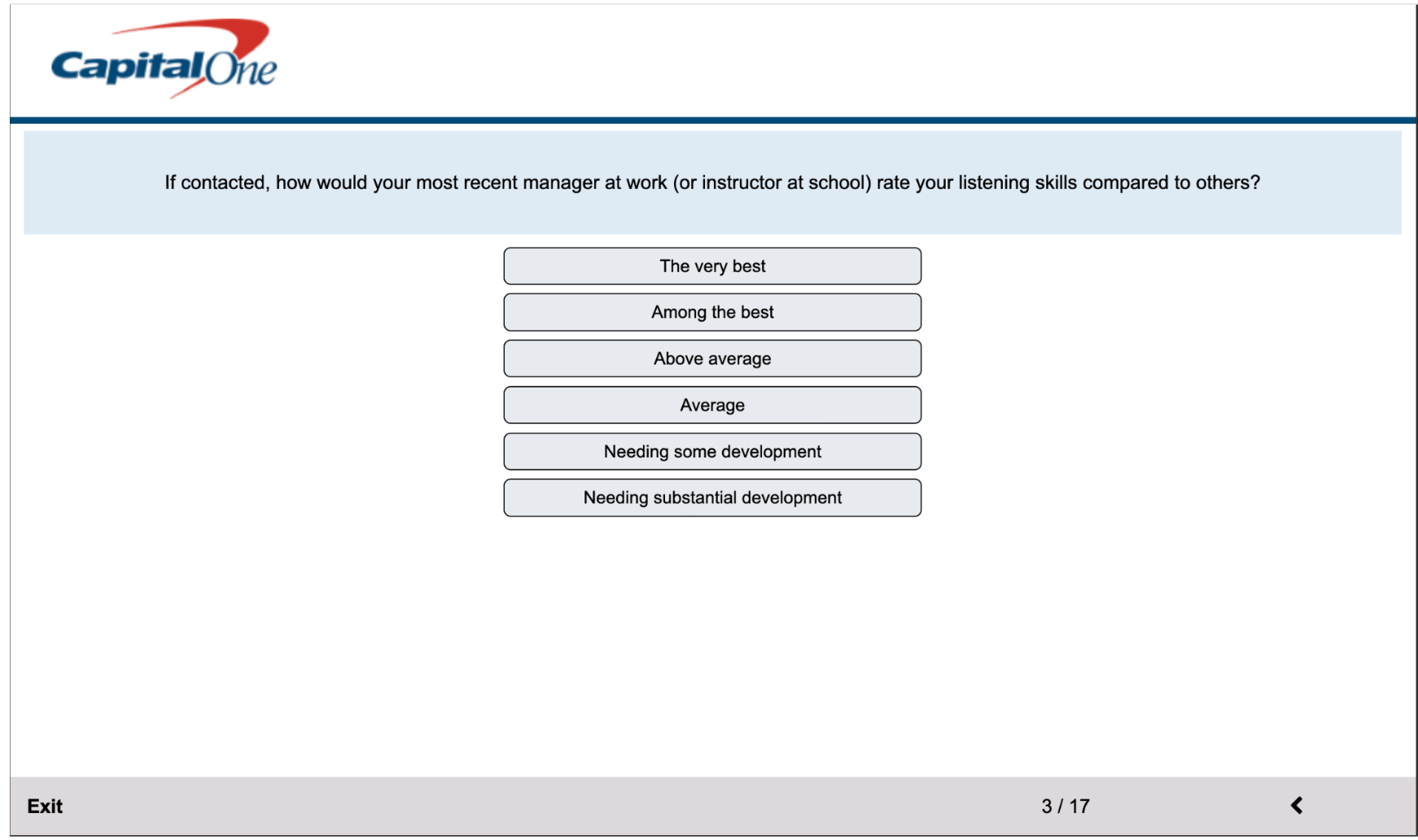Capital One Virtual Job TryOut
- The capital one virtual job tryout includes 5 online assessments and they are
- 🧠 Situational Judgement Test – Realistic workplace scenarios to test decision-making.
- 🔢 Numerical Reasoning – Practice data and chart-based questions similar to the real assessment.
- 💬 Personality Assessment – Example traits and behaviours recruiters look for.
- 🚀 Motivation Test – Understand how your values align with Capital One’s culture.
- 💻 Codesignal Section – Overview of the technical/coding stage with sample question types.
Capital one virtual job tryout questions

Capital one virtual job tryout answers
Answer (Most & Least):
- MOST likely: Tell the experienced teammate about the problem so you can continue making progress without delaying the team. Apologize for interrupting.
- LEAST likely: View this challenge as a great learning opportunity and figure out a solution on your own by using all other available resources.
Why this is best practice
- It’s a potentially major issue with a deadline risk. In corporate SJTs, that means early, concise escalation beats silent solo-problem-solving. You flag risk quickly, unblock yourself/the team, and prevent rework or surprises.
- Interrupting a busy teammate is justified when impact is high—the key is to be brief, prepared, and specific.
How to execute the “MOST” option well (teach-through steps)
- Quick triage (5–10 min): Check specs/docs, prior tickets/wiki, and attempt a minimal reproduction so you can describe the issue clearly.
- Craft a crisp ping:
- Context: “On Project X, I’ve hit [issue].”
- Impact: “If unresolved today, we risk missing [deadline/dependency].”
- What I tried: “Checked A/B, compared to prior task C.”
- Specific ask: “Could you spare 5–10 min now or point me to Y so I can proceed?”
- Parallelize: While waiting, continue on tasks not blocked; keep a batched list of follow-ups to minimise further interruptions.
- Close the loop: Confirm the decision/next steps in writing so the team’s aligned.
Why the others aren’t best here
- “Research similar assignments” – Good habit, but not sufficient when the risk is “potentially major.” Do this before or alongside the quick escalation.
- “Make progress and batch questions” – Efficient for minor issues; risky here because delayed flagging can snowball into missed deadlines.
- “Figure it out entirely on your own” – Shows initiative, but for a high-impact risk it’s unsafe and can waste time or cause costly mistakes.
If you had to rank all four (best → worst):
2 > 4 > 3 > 1.

This type of question is from the personality/behavioural self-assessment part of the Capital One Virtual Job Tryout.
The best approach is to:
- Be confident but credible. If you undersell yourself, you’ll look weaker than peers. If you wildly oversell, it can seem unrealistic.
- Listening is a core competency for teamwork, problem-solving, and customer interaction. Capital One values collaboration, empathy, and communication — so rating yourself highly here is strategic.
✅ Best Answer:
“Among the best.”
💡 Why not “The very best”?
- “The very best” can come across as overly self-inflated (unless you have strong evidence like awards, consistent feedback, or 360 reviews).
- “Among the best” shows confidence + humility. It says you stand out, but you’re not dismissing others’ abilities.
❌ Avoid lower ratings (“Above average,” “Average,” “Needs development”)
- These weaken your application because listening is a universally critical skill. Capital One expects strong communication from successful candidates.
👉 Rule of thumb for these:
- Rate yourself at the top or near the top for universally important soft skills (listening, teamwork, integrity).
- Save “average” or “needs development” for areas that aren’t core to the role (e.g., public speaking if not relevant).



